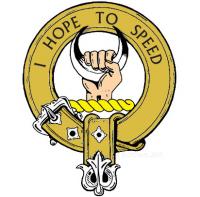
Clan Cathcart
The River Cart runs through Renfrewshire and Glasgow's South side. The name Cathcart is derived from this. The first records of the clan appear in 1178 when Rainaldus de Kethcart was witness to a charter by Walter Fitzalan to the Church of Kethcart for the monastery of Paisley in 1178. His son, William de Kethcart, was witness to another charter around 1200 and Alan de Cathcart sealed a charter of resignation to the Abbot of Paisley of lands at Culbeth in 1234.
His son, William de Cathcart, is listed on the Ragman Roll but he was succeeded by Sir Alan de Cathcart who supported Robert the Bruce. He fought alongside the Kings brother, Edward and had great success in a surprise attack on the English in Galloway during one of the many guerilla style raids during the wars of independence. Sir Alan's close association with the family continued when he married the sister of Sir Duncan Wallace of Sundrum, who had married Eleanor Bruce, Countess of Carrick. His grandson, Sir Alan de Cathcart, obtained estates in Carrick. In 1447 he was later given the title, ‘Lord Cathcart’. The estate of Auchencruive in Ayrshire became the principal family seat until 1718.
The second Lord Cathcart was killed at the battle of Flodden in 1513 and the third Lord met a similar fate at the Battle of Pinkie in 1547. Alan the fourth Lord had strong protestant views and fought against Mary, Queen of Scots at Langside in 1568
Charles Cathcart, the eighth Lord, became a major in the Scots Grays In 1709 and later became colonel of the regiment. He fought against the Jacobites in the 1715 uprising at Sheriffmuir. Charles Cathcart eventually rose to the rank of Major General. The ninth Lord also opposed the Jacobites, was aide-de-camp to the Duke of Cumberland and fought at Culloden. He got the nickname 'Patch Cathcart' due to a patch he wore on his cheek to cover a battle scar. His son also followed a military career, rising to the rank of lieutenant general. He fought against Napoleon and scored a major victory against his forces in Denmark when along with Admiral Gambier he captured sixty Danish vessels in Copenhagen. For this he was made ‘Viscount Cathcart of Cathcart’ and ‘Baron Greenock’ and later first ‘Earl Cathcart’.
The military tradition continued with the second Earl who fought in the Peninsular War and Waterloo. He rose to command the army in Scotland and to govern Edinburgh Castle. The father of the current chief held the rank of major general.




